

THE ULTIMATE GUIDE TO C HURCHILL’S NORTHERN LIGHTS

Churchill lies beneath one of the world’s most active auroral zones, making it one of the top destinations on the planet to view the northern lights.
© G Ciampini
WHY CHOOSE NAT HAB FOR YOUR NORTHERN LIGHTS ADVENTURE?
How to Use This e-book:
• The Contents listed above are live links. Click to jump to the desired page.
• Click “CONTENTS” in the lower right corner to return to this Contents page.
• Other links throughout the e-book are shown in blue, underlined text.


A DANCING SKY
As twilight falls across the frozen landscape of Churchill, Manitoba, something extraordinary begins to unfold. Above the vast, snowcovered tundra, the sky awakens—rippling waves of green and violet light shimmer across the horizon. This is the aurora borealis—also known as the northern lights—one of Earth’s most mesmerizing natural phenomena.
Churchill lies beneath one of the world’s most active auroral zones, making it one of the top destinations on the planet to view the northern lights. Here, far from artificial light, guests enjoy frontrow seats to nature’s celestial performance.
In Churchill, where wilderness meets wonder, the northern lights connect us to the rhythms of nature in its purest form. Nat Hab’s eco-friendly aurora adventures offer exclusive, heated viewing spaces—from our glass-ceilinged Aurora Pod® to a cozy cabin deep in the boreal forest—designed for comfort in the heart of the Arctic winter. During the day, experience northern culture with activities like dog sledding, snowshoeing, and visits with local Indigenous artists and storytellers. At night, watch the sky dance above you as the northern lights come alive.
This guide will illuminate the science and stories of the aurora, as well as the culture and wildlife of Churchill. You’ll also learn how your trip supports the conservation of this enchanting region.
Call 800-543-8917 or visit nathab.com/aurora to learn more.
WHY CHOOSE NAT HAB FOR YOUR NORTHERN LIGHTS ADVENTURE?
Unlike other popular northern lights destinations, Churchill has consistently clear, dark skies—vital conditions for aurora viewing. Situated on the banks of frozen Hudson Bay and directly beneath the aurora oval, Churchill is easy to get to— we charter private flights from Winnipeg to Churchill—and home to a vibrant Arctic community. Plus, our northern lights adventure includes exclusive access, top-tier guides, small group size and commitment to sustainability.

“I loved the opportunities for aurora photography, with expert advice and suggestions from our Expedition Leader.”
-Nat Hab Traveler Karen A., Northern Lights Photo Expedition
NAT HAB’S NORTHERN LIGHTS ADVENTURES
Here’s why our northern lights expeditions stand above the rest:
1
The Best Place on the Planet to See the Northern Lights Churchill is located directly beneath the Van Allen Belt, a layer of energycharged particles that wraps the Earth’s polar regions. Originating in solar flares, these particles are carried by solar wind, becoming trapped in Earth’s magnetic field to create the phenomenon of the aurora. Winter skies are also clearer in Churchill than in other popular aurora-viewing destinations, upping your odds of seeing the lights. Our trips run in midwinter when nights are long and skies are dark, enhancing your chances for the best views.
2
Churchill Is the “Accessible Arctic”
Although Churchill is technically subarctic, lying below the Arctic Circle, its location on the edge of the frozen expanse of Hudson Bay gives it a distinctly Arctic climate and cultural identity. Yet unlike getting to the top of Norway or Siberia or into the interior of the Yukon to see the northern lights, Churchill is easy to reach by air from Winnipeg, Manitoba’s capital and largest city, which is served by many direct flights from the U.S.

© E Savage
Unique Private Settings for Aurora Viewing & Photography
Each of our private aurora-viewing settings is situated well away from town lights, and guests will visit a selection of them during their tour. Your mix of heated viewing destinations may include:

Our two-story Aurora Tower with a clear curved top and multi-level viewing spots.
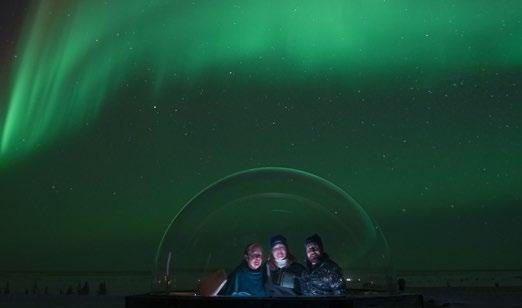

The intimate Aurora Sphere, a furnished geodesic dome with clear panels that’s heated by a wood stove.


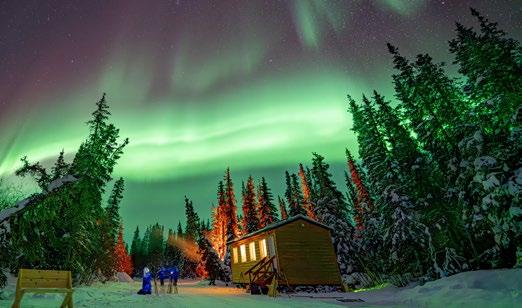
Our Aurora Pod® with a clear glass roof and half-side.
Plexiglass-topped Aurora Domes offering a circular view on the night sky.
A dog musher’s camp where an illuminated tepee and campfire provide an evocative foreground for photos.
A cabin tucked deep within the boreal forest.
© G Ciampini
© P Gheorghe
© P Gheorghe
© L Thompson
© A Amsel
4
A Wilderness Snowcoach Expedition
Ride on a custom-built snowcoach into the boreal forest, crossing a frozen creek to reach our private cabin. No one else has access to this roadless wilderness!
As we head deep into the North Woods, look for moose and wolf tracks and elusive winter wildlife. Gather in our cabin, tucked within the forest and warmed by a wood stove, to spend an evening searching for the northern lights.
Private Chartered Flights to Maximize Your Time in Nature
5 6 7 8
We bypass commercial flights by chartering our own aircraft directly from Winnipeg to Churchill. This means less time in airports, more time in the wild, and a seamless, stress-free journey.
More Than Just Northern Lights: Dog Sledding & Cultural Experiences
The aurora may be top draw, but you’ll enjoy a whole host of northern activities for a comprehensive Arctic adventure:
• Meet a Churchill dog musher and ride behind a team of sled dogs through the boreal forest
• Engage with Indigenous storytellers who share the traditions and history of the North
• Track hardy northern wildlife on a snowshoeing outing, including mammals like Arctic hare and Arctic and red foxes, as well as birdlife such as snowy owls and willow ptarmigan
The Finest Naturalist Guides in the Industry
Our Expedition Leaders are the best in the business. With an average of more than 15 years of guiding experience, their deep knowledge of the northern lights, Arctic ecology, Churchill’s history and culture, and conservation transforms every moment into an enriching educational experience. Our philosophy is simple: A nature adventure is only as good as the guide, so we provide the very best.
A Commitment to Sustainability
Since 2003, we have been the travel partner of World Wildlife Fund, the world’s leading environmental conservation organization. And as the world’s first carbon-neutral travel company, Nat Hab offsets 100% of the emissions from your trip. This includes your round-trip flights, making your adventure as eco-conscious as it is extraordinary.

“I enjoyed every facet of the trip: the Expedition Leader, the aurora, the dog sledding, the museum, snowshoeing—even putting on all our gear! My least favorite thing was having this adventure end.”
-Nat Hab Traveler Christine R., Northern Lights Photo Expedition
THE NORTHERN LIGHTS: SCIENCE & STORIES
The northern lights are a spectacular natural phenomenon that transforms the night sky with vibrant displays of color and movement. These luminous ribbons of light appear when charged particles from the sun interact with Earth’s magnetic field and atmosphere. Not surprisingly, given their aweinspiring visuals and seemingly mysterious appearances, the aurora has been the subject of myth and legend for people across the planet for centuries.


THE SCIENCE BEHIND THE NORTHERN LIGHTS
WHAT CAUSES THE NORTHERN LIGHTS?
The process begins with the sun emitting a stream of charged particles known as the solar wind. When these particles reach Earth, most are deflected by the planet’s magnetic field. However, near the polar regions—where the magnetic field is weakest— some particles funnel into the upper atmosphere along magnetic field lines. There, they collide with gas molecules such as oxygen and nitrogen.
These collisions transfer energy to the atmospheric gases, which then release that energy in the form of light, creating the glowing waves we see in the sky. The more active the sun, the harder the solar wind blows. And the more powerful the solar wind, the more brilliant the aurora borealis.
WHY ARE THE NORTHERN LIGHTS SO STRONG IN CHURCHILL?
Auroras typically occur in an oval-shaped band centered around each magnetic pole, called the auroral oval. Churchill, Manitoba, lies directly beneath the auroral oval in the Northern Hemisphere, making it one of the best places on Earth to view the northern lights. Here, the combination of frequent geomagnetic activity and clear winter skies creates ideal conditions for witnessing this awe-inspiring spectacle.
HOW CLOSE ARE THE NORTHERN LIGHTS?
Although the lights appear to occur very close to the Earth’s surface, the aurora is actually miles away. At its closest, it is 40 miles from the ground, while at its farthest, it can be almost 600 miles above the planet.
© E Savage
CAN YOU HEAR THE NORTHERN LIGHTS?
Although most people observe the northern lights without hearing a sound, some have claimed to hear noises such as slight cracklings or rustlings, whizzes, swooshes, snaps, and pops while viewing the aurora. There is currently no theory that adequately explains these sounds, but most of these auditory observations seem to have occurred during long, powerful auroral displays directly over the viewers’ heads. Those who believe auroral sounds exist suggest they may be created when electromagnetic waves are transformed into acoustic waves.
WHY ARE THE NORTHERN LIGHTS DIFFERENT COLORS?
The color of the aurora depends on both the type of gas molecules involved and the altitude of the collisions. Green is the most common color and occurs when solar wind collides with oxygen molecules about 60 to 150 miles above Earth’s surface. Red auroras, also caused by oxygen, occur at higher altitudes and are less common. Nitrogen produces blue or purplish-red hues, adding to the dynamic palette of the aurora.
WHEN IS THE BEST TIME TO SEE THE NORTHERN LIGHTS IN CHURCHILL?
There’s always a chance to see the aurora borealis when you visit the world’s northernmost regions, since solar activity and massive solar eruptions can happen at any time. However, the best time to take a trip to see the northern lights is during the longest and darkest nights of the year, typically January through March. During this time of year, the aurora borealis is most likely to appear between 9 p.m. and 3 a.m.

STORIES OF THE NORTHERN LIGHTS
Although modern science has explained what causes the northern lights, it’s easy to understand how so many cultures came to develop mystical stories about them. The aurora, with its striking colors and dance-like movements, seems otherworldly. The lights gave some communities comfort and happiness, while others dreaded their reappearance, considering them a bad omen.
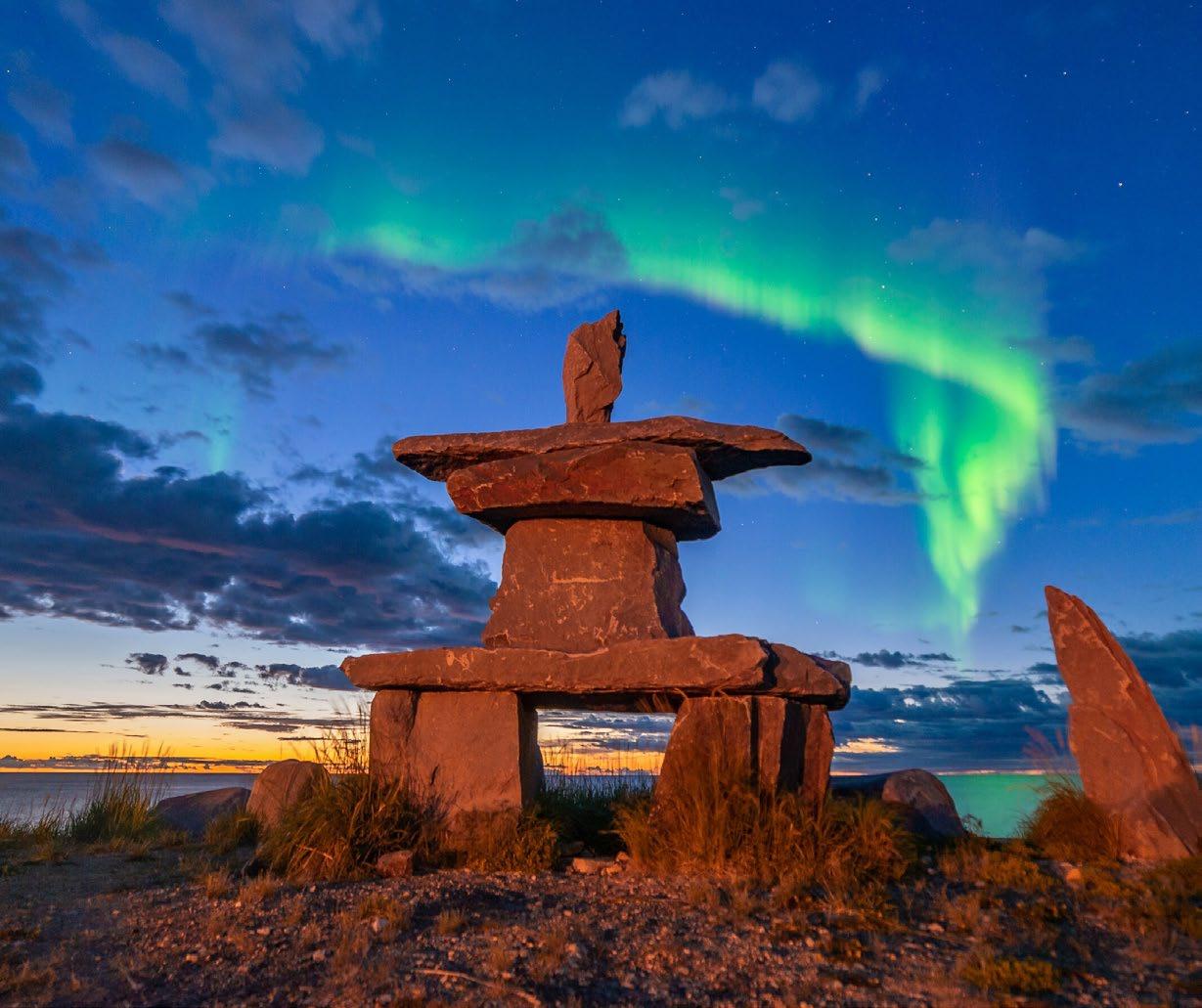
© E Savage
Here are just a few of the myths and legends of the northern lights:
• When they witnessed the lights, many Inuit, the Arctic’s Indigenous peoples, believed they were spirits of the dead playing a game with a walrus skull as the “ball.” (The Inuit of Nunivak Island in the Bering Sea had their own flipped take on this story, believing that it was walrus spirits playing with a human skull!)
• The Inuit of Hudson Bay dreaded the lights, believing they were the lanterns of demons pursuing lost souls.
• Indigenous Greenlanders believed that the lights were the dancing spirits of children who had died at birth.
• For Wisconsin’s Fox Native Americans, the aurora gave them a sense of foreboding, representing their slain enemies preparing for revenge.
• In Alaska, some Inuit groups saw the lights as the spirits of the animals they had hunted, such as beluga whales, seals, salmon and deer.
• In Norse mythology, the lights were the spears, armor and helmets of the warrior women known as the Valkyries. They rode on horseback, leading fallen soldiers to their final resting place at Valhalla.
• In Finland, a mystical fox was thought to have created the aurora, its bushy tail spraying snow and throwing sparks into the sky.
• In perhaps the best oxymoron in British folklore, Scottish legend refers to the lights as “Merry Dancers” engaged in bloody battle.
• Some Algonquin peoples believed their cultural hero, Nanahbozho, relocated to the far north after he finished creating the Earth. He lit large fires, which reflected back to his people in the form of the northern lights. This let them know he was thinking of them, even from far away.
• Native Americans of the Great Plains thought the light display came from northern tribes cooking their dead enemies in huge pots over blazing fires.
• Inuit in Point Barrow, Alaska’s northernmost spot, believed the aurora was evil. They carried knives to protect themselves from it.
• In Estonia, one legend said the lights appeared when whales were playing games. Another said they were sleighs taking guests to a spectacular wedding feast.
• Wisconsin’s Menominee Native Americans saw the lights as torches used by benevolent giants to spear fish at night.
• Fishermen in northern Sweden took the lights as a good omen, believing they reflected large schools of herring in nearby seas.
• If you whistled at the aurora, some Native Americans believed it would sweep down and take you away. Clapping your hands, however, would cause the lights to retreat, keeping you safe. Meanwhile, in northern Scandinavia, the Sami people hid indoors during the light show.
WILDLIFE OF CHURCHILL
In fall and summer, Churchill’s tundra buzzes with life, from the enormous polar bears that gather here each autumn to the friendly beluga whales that migrate to the Churchill River each summer. But come winter, the same northern expanse becomes an icy realm. However, a few mammals and birds live here year-round, relying on remarkable adaptations to endure the cold.
ARCTIC FOX: SURVIVOR OF THE FROZEN NORTH
The Arctic fox is a master of survival. Roughly the size of a large house cat, the Arctic fox appears round and plush in winter, its fluffy white coat offering critical camouflage. Beneath the thick fur, however, lies a lean, agile predator weighing just 10 pounds.
A cunning opportunist equally adept at hunting and scavenging, the Arctic fox moves easily through the snow with heat-conserving, fur-covered footpads—nature’s version of snow boots. The fox’s hypersensitive hearing gives it the uncanny ability to detect prey hidden beneath the snow. Patiently, it listens for the faint rustle of a creature tunneling below. Then, with a dramatic, high-arching pounce, it leaps high into the sky before plunging nose-first through the snow and seizing its prey with deadly precision. This signature technique makes it one of the tundra’s most efficient predators.

© J Gilligan


ARCTIC HARE: THE TUNDRA’S ELUSIVE SHADOW
A flash of white against the snow—then gone. Though delicate in appearance, the Arctic hare is one of the region’s most resilient survivors—a master of stealth that relies on stillness and speed to survive in one of the world’s most inhospitable landscapes.
With powerful hind legs, it can outrun an Arctic fox, reaching speeds of up to 45 mph—faster than an Olympic sprinter. But it rarely flees unless necessary. Instead, it relies on its near-perfect camouflage, staying still until the threat has passed.
Unlike its woodland cousins, the Arctic hare does not hibernate. Instead, it forages year-round, gnawing on willows, grasses and frozen twigs to survive the barren winters. In especially harsh conditions, hares have been known to dig beneath the snow for lichen, scraping out a meal where others would starve.
Though often solitary, Arctic hares occasionally form large groups of up to 300 individuals, huddling together for warmth against the brutal Arctic winds. This communal survival strategy, combined with their dense fur and thick fat reserves, allows them to endure even when temperatures plummet to lethal lows.
© A DeVries
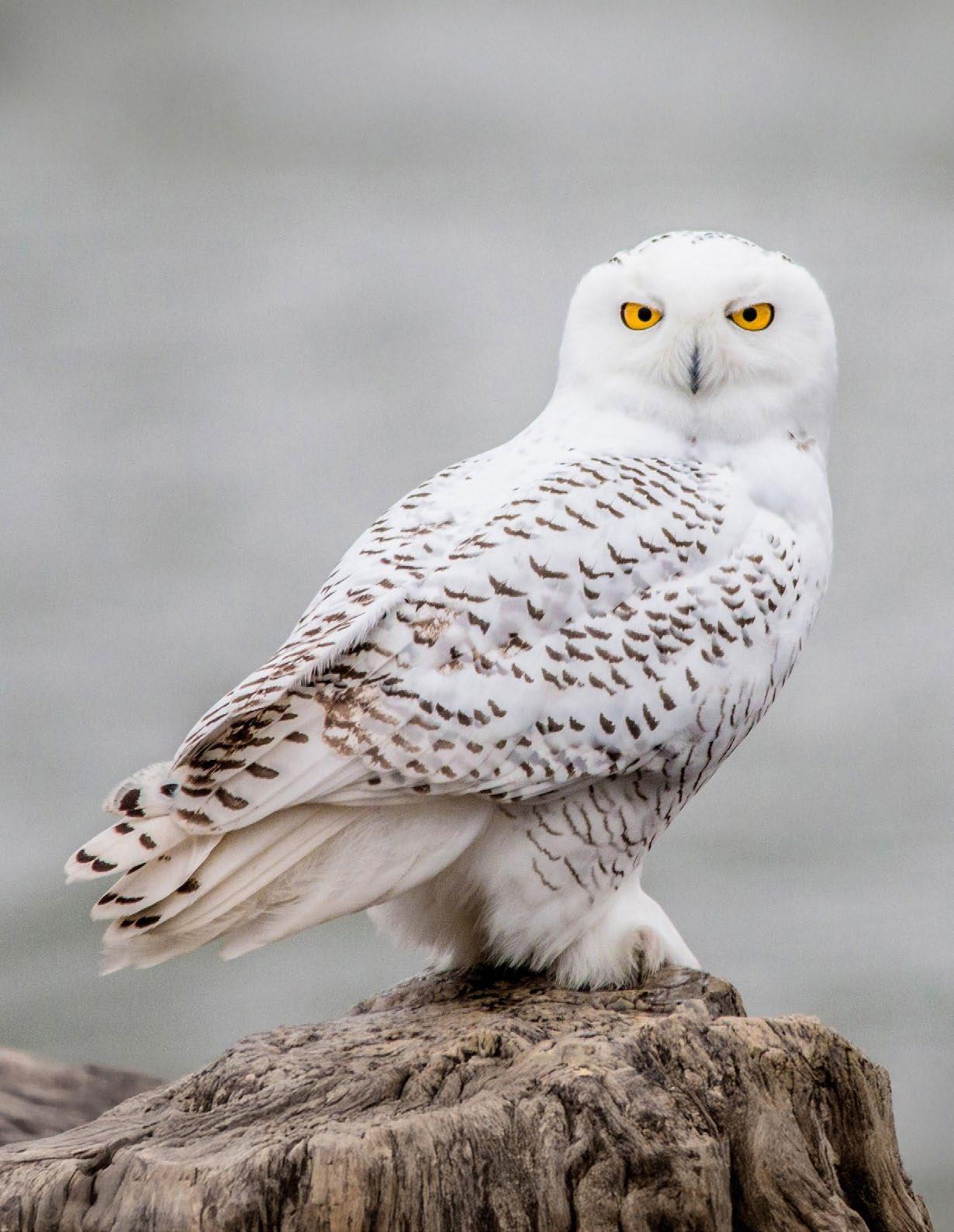
© S Kinsey
SNOWY OWL: GHOST OF THE ARCTIC SKY
Drifting silently over the tundra, its golden eyes piercing the endless white, the snowy owl is both predator and phantom—a master hunter in a world of ice and shadow.
Snowy owls are primarily white, but they have dusky flecks and bands of dark brown cutting across their plumage. They have yellow eyes and white feathers that cover their feet and legs, protecting them from the frigid Arctic weather.
With a wingspan of over 5.5 feet and weighing between 3.5 and 6.5 pounds, this Arctic raptor is one of the largest owls on the planet. A single snowy owl can consume more than 1,600 lemmings per year. In lean times, it will hunt Arctic hares, ptarmigans, ducks and even fish, swooping down with razorsharp talons to snatch prey straight from the ice or water.
Unlike most owls, the snowy owl is not strictly nocturnal. In the land of the midnight sun, where daylight can last for weeks, it hunts whenever opportunity strikes—day or night, dawn or dusk.
Snowy owls lay up to 11 eggs in a clutch, with an average of 4 to 6 hatching (depending on food availability), ensuring the next generation continues to rule the Arctic skies.
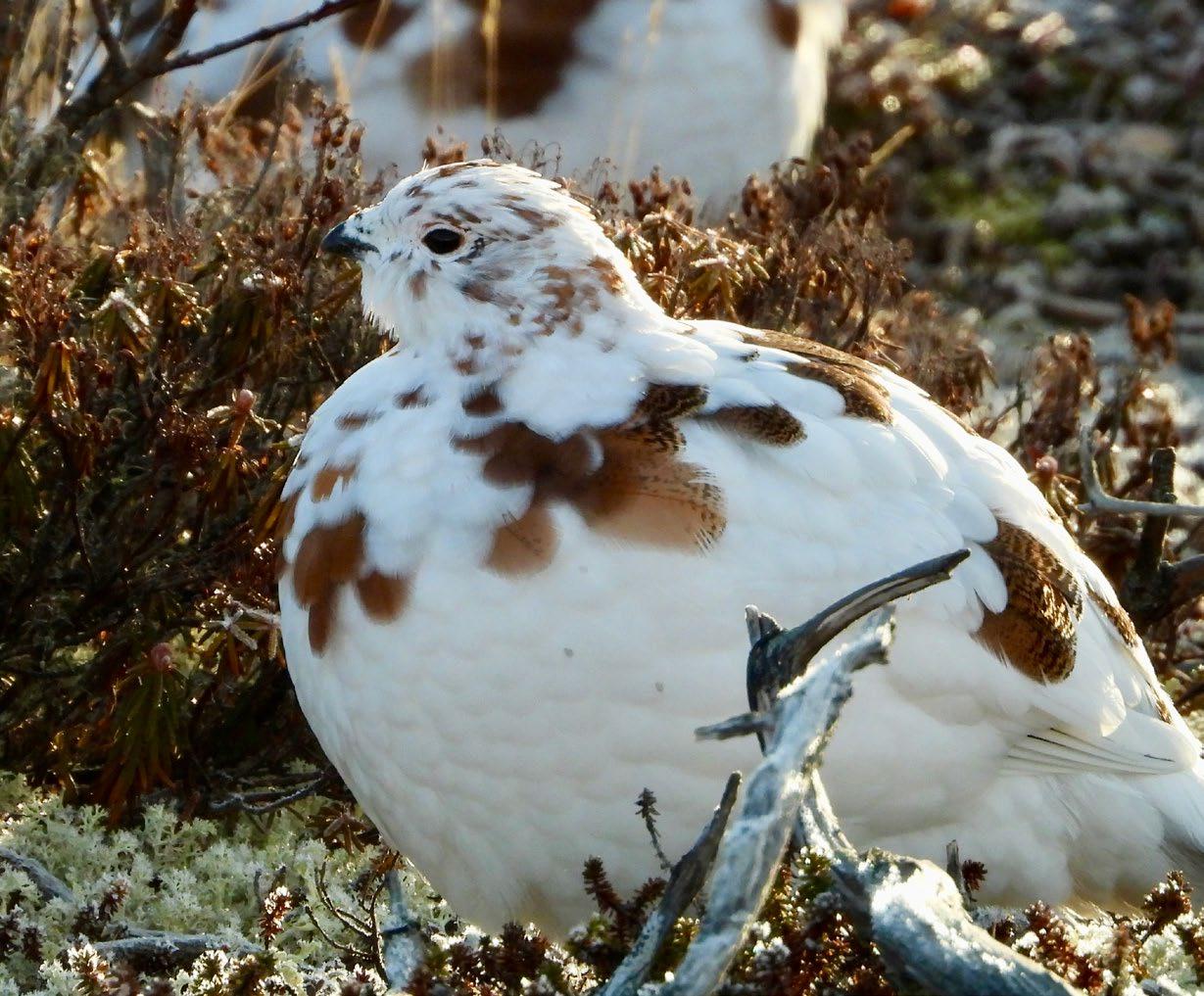

WILLOW PTARMIGAN: TUNDRA CHICKEN
With squat, rounded wings and a slight black bill, the willow ptarmigan resembles a chicken. Reaching 15 to 17 inches long, it is the largest of the three species of ptarmigan. Males weigh just over one pound, and females weigh a little less. The red comb above their eyes and the square tail that remains black all year distinguish this bird from other ptarmigans.
Willow ptarmigans are marvelously adapted to their Arctic environment. Thick feathers cover their legs and hide their nostrils to prevent snow from getting in. In autumn, ptarmigan grow a solid clump of rigid feathers over their toes. These feather-covered feet act like snowshoes in winter, while their sharp, elongated claws assist with crossing icy slopes.
In winter, ptarmigan are snowy white, but their feathers change seasonally. Willow ptarmigan favor summering sites on the tundra, in the alpine tree line boundary and on mountain slopes. In winter, birds nest in willow trees and sheltered valleys.
© M Bourke
CONSERVATION & COMMUNITY INITIATIVES
As one of the first companies to operate adventures in Churchill decades ago, Natural Habitat Adventures is intimately acquainted with the community and region. We are committed to preserving the environment and wildlife of Churchill and Arctic Canada, and conservation travel helps accomplish this.
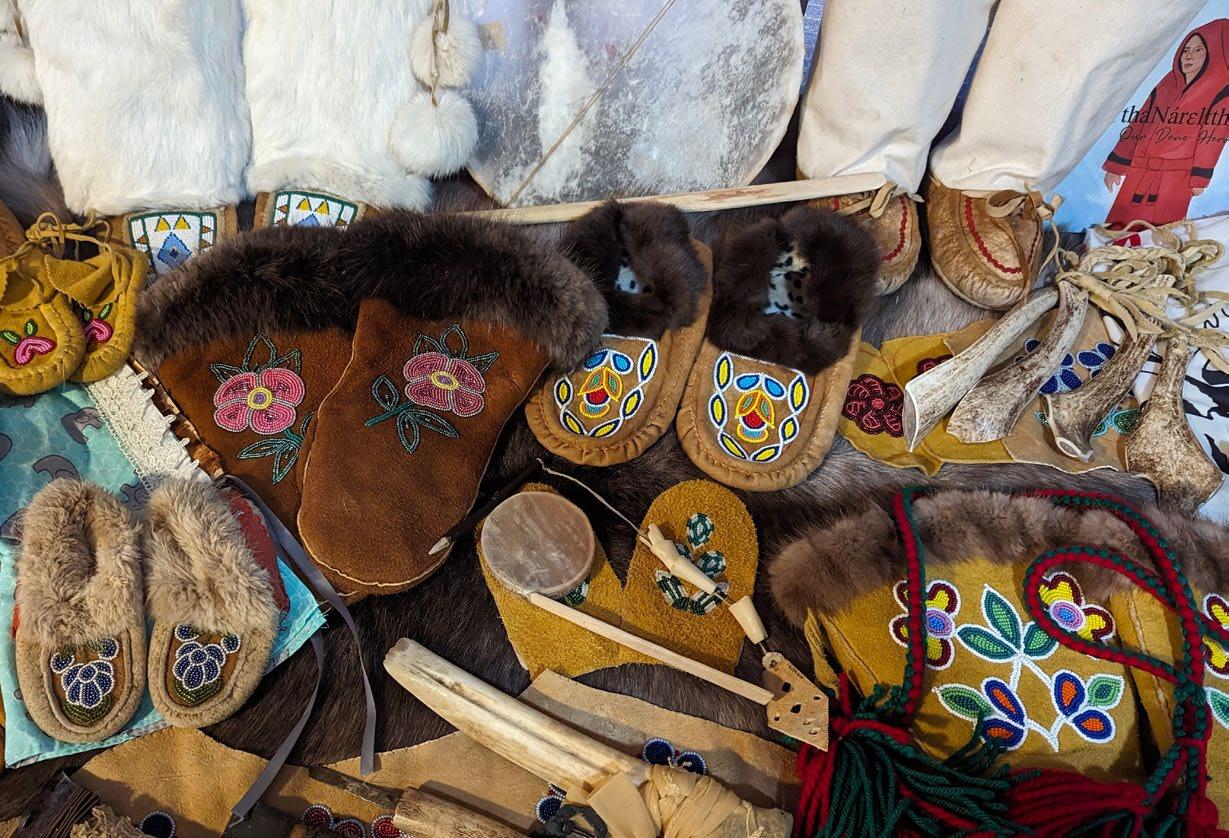
“I was ready to see some amazing aurora displays (which we did!), but I wasn’t expecting just how impactful our interactions with members of the community would be. It was wonderful to hear about their beliefs, values, struggles and triumphs.”
-Nat Hab Traveler Rebecca L., Northern Lights Photo Expedition
Through operating environmentally sensitive expeditions for hundreds of visitors each year, we contribute financially to Churchill while using travel to raise our guests’ awareness and inspire their own conservation efforts.
Natural Habitat Adventures also contributes to World Wildlife Fund’s efforts in the area, as well as to the whole of its Arctic programs. Our goal is to go beyond merely showcasing nature and wildlife to directly contribute to the well-being of Churchill and the surrounding environs that sustain its resident wildlife.
© S Moll
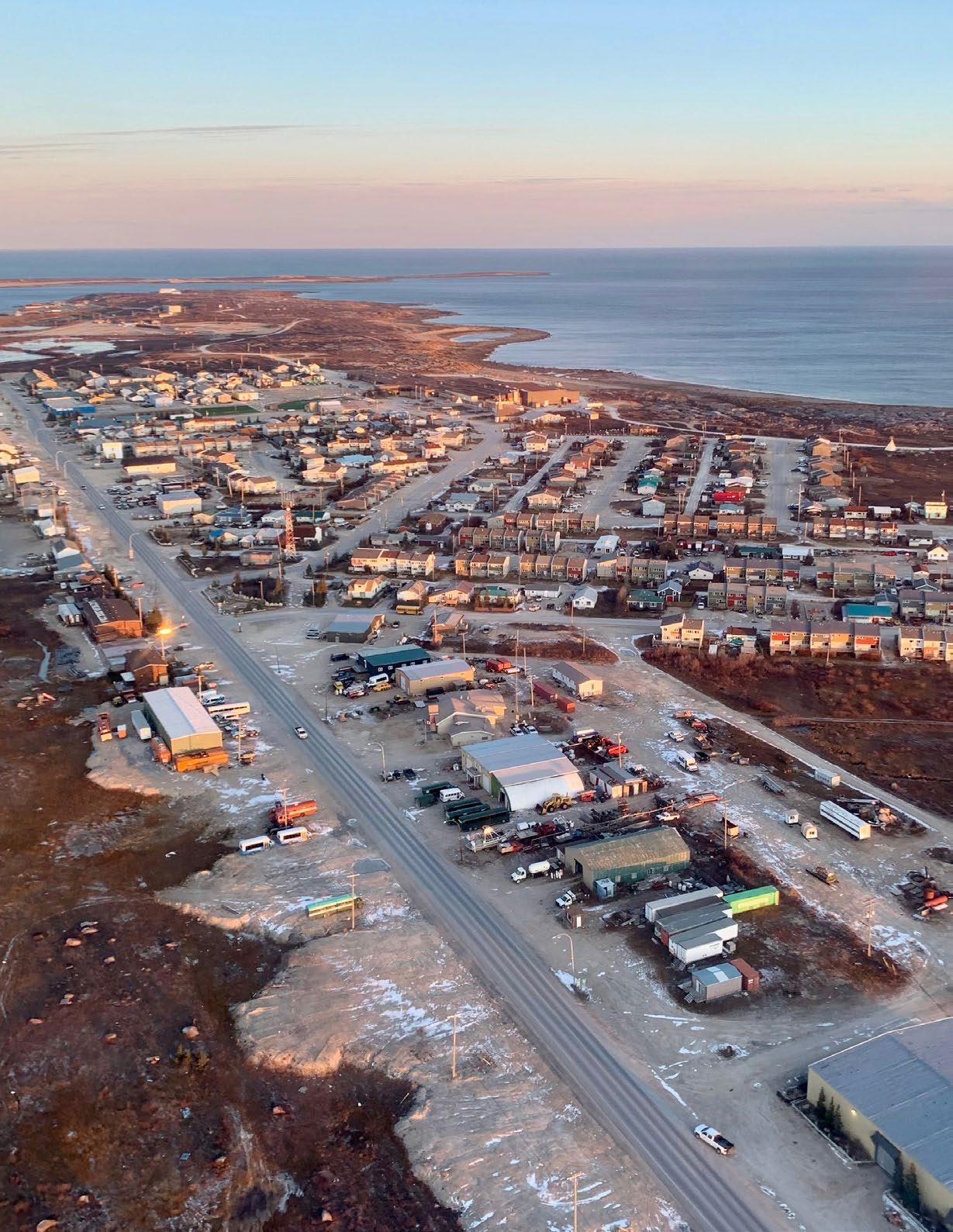
© A Mallinson
SUPPORTING FOOD SECURITY IN THE ARCTIC: A GREEN REVOLUTION IN THE FROZEN NORTH
Survival in the far North has always required ingenuity and resilience. In Churchill, Manitoba, where there are no roads connecting the town to the rest of Canada, food arrives by seasonal trains or air shipments. A severe weather event can cut supply lines and increase grocery prices overnight—a carton of milk or a head of lettuce can become an unaffordable luxury.
Recognizing this challenge, Natural Habitat Adventures has partnered with Churchill’s leaders to support residents in multiple ways, including:
• Hosting annual Thanksgiving celebrations and community breakfasts for hundreds of townsfolk.
• Providing food for school breakfast programs to ensure children start their day with a nourishing meal.
• Contributing leftover groceries from expedition meals to local food banks.
But the most innovative solution isn’t about improving supply chains—it’s about rethinking food production altogether.


At the Churchill Northern Studies Center, a hydroponic greenhouse has transformed how fresh produce reaches the community. In a place where traditional farming is impossible, this indoor vertical farm grows and supplies lettuce, kale and herbs to local grocery stores, restaurants, and the hospital cafeteria.
Nat Hab funded the center’s hydroponic cabinet, an educational tool that allows scientists, residents and visitors to learn firsthand about sustainable Arctic agriculture.
“Churchill is a cold tundra most of the year,” says Court Whelan, Nat Hab’s Chief Sustainability Officer.
“We invested in hydroponic farming to help them grow fresh greens year-round. If you’re headed on a Nat Hab Northern Lights trip, you’ll likely have your own Rocket Greens salad!”


CHURCHILL’S MURALS: ART AS A VOICE FOR THE NORTH
When a three-day blizzard in 2017 swept across Churchill, it exacerbated the existing isolation of this remote region. Flooding washed out the only railway connecting Churchill to the rest of Canada, severing critical supply lines. No trains. No travelers. No supplies. Businesses shuttered. Food prices soared. For 18 months, Churchill waited, cut off from the world.
Churchill’s
But in the face of hardship, Churchill adapted. People couldn’t come to Churchill, but Churchill could bring its story to the world through art. A collaboration between artist Kal Barteski of the Polar Bear Fund and Pangea Seed Foundation invited muralists from around the globe to turn Churchill’s blank walls into canvases for conservation..
murals speak for the North, telling a story of struggle, survival, and hope—one brushstroke at a time.
© L Paxton



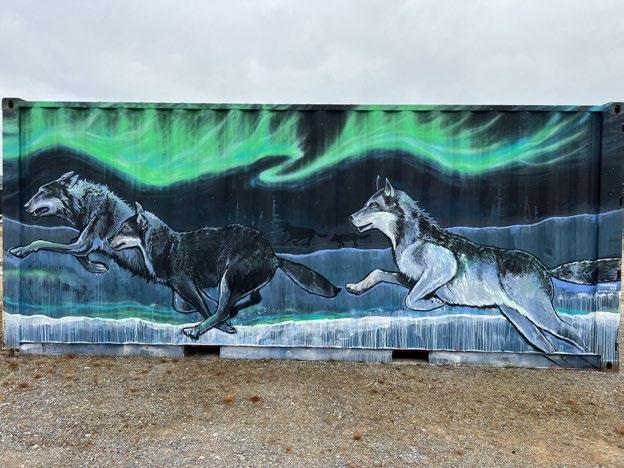
Today, 18 large-scale murals in town pay tribute to the Arctic’s wildlife, people, and challenges:
• The aurora borealis, in cascading shades of green and purple, mirrors the real-life spectacle that graces Churchill’s skies over 300 nights a year.

• A polar bear, painted in striking shades of blue and white, stands watchfully over the tundra—a silent guardian of its disappearing home.
• A breaching whale, swirling in turquoise, honors the belugas that return to the Churchill River each summer.
• The words “Know I’m Here” stretch across one mural—a poignant reminder that Churchill refuses to be forgotten.
© B Rennison
© A Drwencke
© C Soderstrom
© J McClean
© J Wilkie


What began as a response to crisis has become a defining feature of Churchill, drawing visitors from around the world. The murals are a declaration of resilience, a statement of identity, and a call to action.
© G Ciampini
© B Yeow

© P Ramsden
SUGGESTED READING
Whether you’ve already booked your trip or it’s at the top of your travel list, you don’t have to wait to immerse yourself in the northern lights. For those eager to deepen their connection to Churchill’s landscapes, history and wildlife, these books provide a gateway to the Arctic experience.
Arctic Dreams | Barry Lopez
A lyrical and deeply researched meditation on the Arctic, Lopez blends natural history, Indigenous perspectives and personal reflections into an unforgettable portrait of the North. His vivid descriptions capture the stark beauty of frozen landscapes and the extraordinary lives of the creatures that call it home.
A Naturalist’s Guide to the Arctic | E. C. Pielou
An essential primer on Arctic climate, geography and wildlife, this book is ideal for travelers looking to understand the intricate relationships within the Arctic ecosystem. It’s a field guide and a love letter to the North rolled into one.
A History of Arctic Exploration | Juha Nurminen
From Vikings and whalers to daring polar explorers, this lavishly illustrated volume chronicles humanity’s obsession with the Arctic. Featuring historical maps and expedition accounts, it’s a fascinating deep dive into the long pursuit of the Northwest Passage.
The Northern Lights: The True Story of the Man Who Unlocked the Secrets of the Aurora Borealis | Lucy Jago Science, biography and Arctic exploration converge in this extraordinary true story of the life and work of Norwegian scientist Kristian Birkeland, the troubled genius who solved the mysteries of one of nature’s most spectacular displays.
The Last Imaginary Place | Robert McGhee
A fascinating look at the history of Arctic peoples and cultures, from the ancient hunters of Beringia to today’s Inuit communities. McGhee’s writing is both scholarly and deeply personal, offering a unique perspective on Arctic survival.
The Man Who Ate His Boots | Anthony Brandt
This riveting historical narrative follows the ill-fated search for the Northwest Passage, chronicling the triumphs and tragedies of Arctic exploration. It’s a tale of ambition, endurance and the unforgiving reality of the frozen North.
Ice Bear Escapade (Buddy the Globetrotter) | R.E. Burke
Perfect for younger explorers, this delightful adventure story follows a globetrotting dog named Buddy on a journey through Churchill’s icy wilderness. Packed with fun facts and engaging storytelling, it’s an educational and entertaining introduction to the Arctic.
Permanent Astonishment | Tomson Highway
A powerful memoir from renowned Cree author Tomson Highway, chronicling his early life in subarctic Canada. His vivid storytelling paints a rich picture of northern life, resilience and Indigenous heritage.
Expedition Churchill (e-Book)
Expedition Churchill is an interactive journey to the heart of scientific discovery. Discover the region, climate and research taking place in Churchill and Hudson Bay—our gateway to the Arctic. Download the e-book here: umanitoba.ca/research/expedition-churchill.
Where is the best place to view the northern lights?
The northern lights—or aurora borealis—can be seen in a variety of locales throughout the polar north, but the most vivid displays occur underneath an oval-shaped ring that circles the North Geomagnetic Pole. Churchill, Manitoba, sits underneath the aurora oval along the frozen Hudson Bay, which provides more reliable winter weather compared to islands and marine coastal areas elsewhere near the poles.
What causes the aurora borealis?
When charged particles emitted from the sun during a solar flare strike atoms in the Earth’s atmosphere, electrons release a photon, or a particle of light. The high quantity of these collisions in Earth’s atmosphere produces various colors, which creates the aurora borealis. Learn more about this natural phenomenon on pages 14-15.
What is the best time to see the northern lights in Churchill?
The best time of year to view the aurora borealis is January through March because of significantly clearer skies than other months.
What is the weather like in Churchill during the winter?
Daily temperatures rarely rise above 0ºF, though it could be markedly colder. Nighttime lows are between -17 to -27ºF. Days tend to be dry and sunny, though there is rain or snow an average of three to four days each winter month. Because Churchill is located along Hudson Bay, winds can be high.
What time do Nat Hab trips head out to watch the northern lights each night?
Every night is different, but we head out to one of our northern lights viewing locations shortly after dinner. Most locales provide comfortable and ample space to wait for the lights to appear. While waiting, your Expedition Leader may give a presentation, or we might hear stories from a local. Often the group will stay up until after midnight, depending on the aurora activity that evening.
Am I guaranteed to see the northern lights every night in Churchill during the winter?
It’s impossible to guarantee anything in nature, including the appearance of the northern lights. However, after operating hundreds of departures during our decades of aurora viewing in Churchill, Manitoba, we have missed the lights only a handful of times.
Will I see polar bears in Churchill during the northern lights season?
Prime polar bear viewing season in Churchill is during October and November. When the ice forms across the water of Hudson Bay during late fall into the winter months, the bears disperse onto the northern bay to hunt. You can find our Polar Bear Adventures here.
What wildlife are we likely to see on the tundra?
On our northern lights trips, we often see Arctic fox, snowy owl and Arctic hare. Occasionally we see red foxes, snowshoe hares and willow ptarmigan. Check out our Churchill Wildlife Guide.
What gear is provided on Nat Hab’s Northern Lights trips?
So that our guests do not have to purchase expensive winter expedition clothing that might be used only once, Nat Hab provides guests with high-quality, down-filled parkas. We also include the use of warm snow pants, a fleece jacket, mittens, and Arctic boots.
What clothing should I pack for the winter weather in Churchill?
We recommend travelers wear layers on this trip, starting with a thin base layer, a second fleece layer, and a heavy outer layer that is of the warmest variety and is also water repellent and wind resistant. A down winter parka, insulated pants, fleece jacket, hat, mittens, neck gaiter, and a pair of boots will be provided by Nat Hab, but thin gloves are highly recommended to ensure no bare skin is exposed to the elements, even when taking pictures. Snow and even rain may be expected. For further details of what to bring, peruse this helpful packing list and check out Nat Hab’s online Gear Store for some of the key items recommended for your adventure.
Can I use U.S. dollars in Winnipeg and Churchill?
U.S. dollars are widely accepted in Canada, but we recommend you exchange money to Canadian currency before arrival in Churchill. Click here for the current exchange rate. Many but not all services in Manitoba take credit cards. There is an ATM at the Fort Garry Hotel.
Ready to test your knowledge? Take our northern lights quiz to see how much you know about the aurora borealis!
Can I go on a photo expedition even if I am not a great photographer? Are northern lights photography expeditions okay for beginner photographers?
Absolutely! In fact, it is encouraged, as this is the best way to learn from your professional photographer Expedition Leader.
Are Nat Hab’s northern lights adventures suitable for children?
We strongly encourage you to call our office at 800-543-8917 to speak with an Adventure Specialist about the requirements of our specific Churchill adventures. If you are looking for a trip designed specifically for children and families, consider our Family Adventures.
Can Nat Hab take our family or a group on a private version of a northern lights adventure?
Yes! Families or friend groups can reserve entire departures on a private basis. Please call our office at 800-543-8917 to get details on group size and pricing.

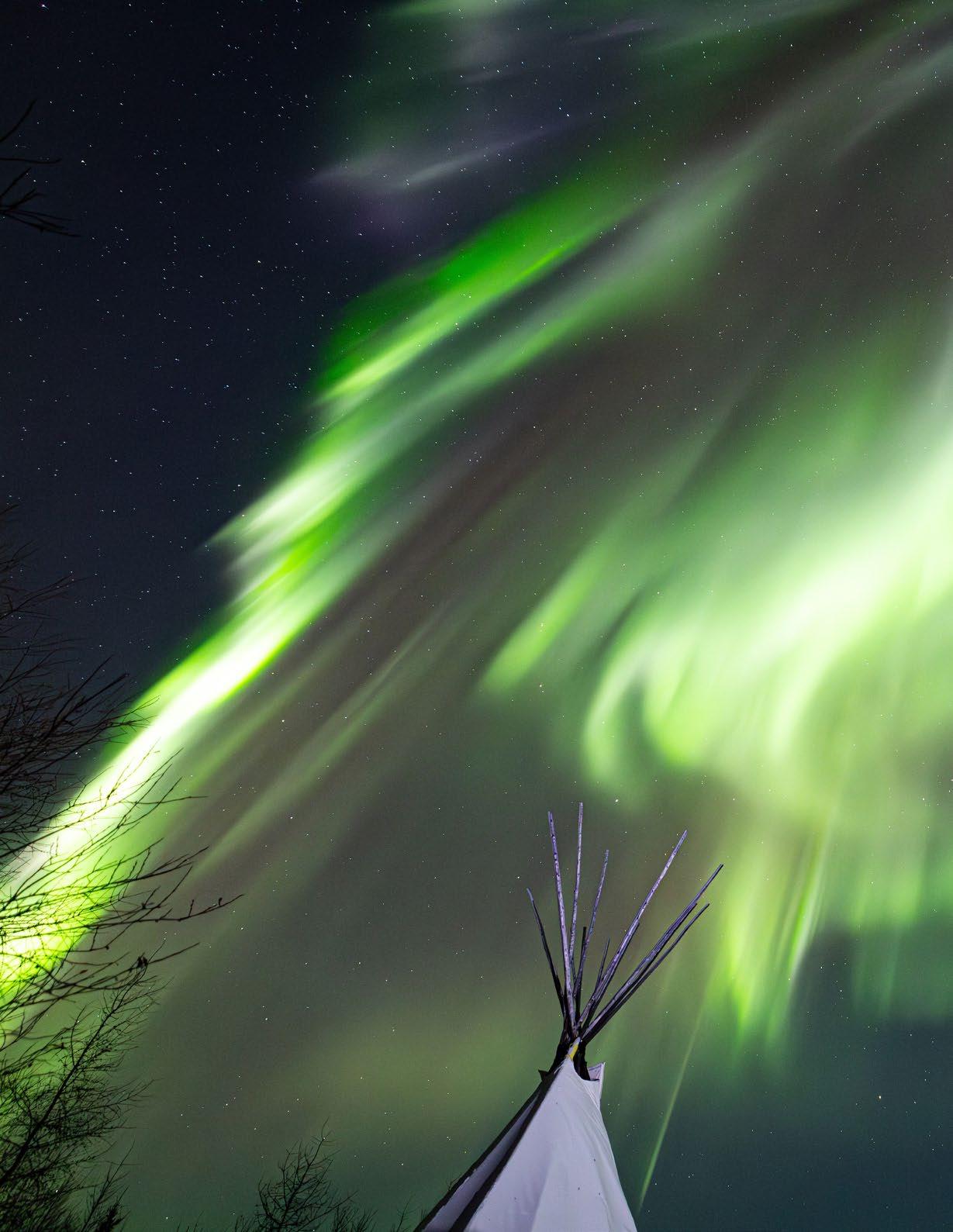

THE ARCTIC AWAITS
Northern lights season in Churchill is more than a chance to see the aurora borealis—it’s a window into a world few get to experience. For those who journey here, Churchill offers not just unforgettable sights, but a deeper understanding of the Arctic—its challenges, its wonders, and its fragile future.
Once you have stood on this land, gazed into the endless white, and watched the northern lights dance across the sky, a part of the Arctic will stay with you forever.
Call our office at 800-543-8917 to learn more about our Churchill adventures.
© L Thompson

